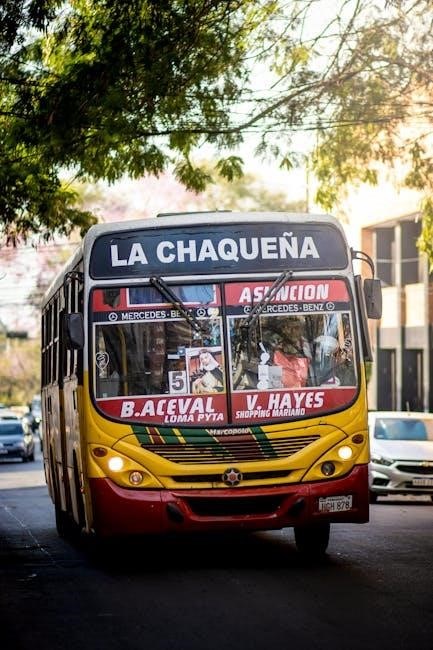Understanding French road signs is essential for safe driving and adhering to traffic rules. These signs‚ categorized by shape‚ color‚ and purpose‚ guide drivers through diverse road conditions‚ ensuring clarity and safety. Recognizing them is crucial for all road users to navigate effectively and avoid hazards. Regular updates and revisions ensure the signs remain relevant to modern traffic needs‚ making them a cornerstone of France’s road safety system.
Importance of Knowing Traffic Signs
Knowing traffic signs is fundamental for ensuring road safety and smooth circulation. These signs provide critical information to drivers‚ pedestrians‚ and cyclists‚ helping them navigate roads confidently. By understanding the meaning of each sign‚ road users can anticipate potential hazards‚ follow traffic rules‚ and make informed decisions. This knowledge significantly reduces the risk of accidents and ensures compliance with legal requirements. Ignoring traffic signs can lead to dangerous situations‚ fines‚ or even legal penalties. Additionally‚ recognizing signs helps drivers adapt to changing road conditions‚ such as construction zones or temporary restrictions. Regular updates to traffic signs reflect evolving road safety needs‚ making it essential for all users to stay informed. Ultimately‚ understanding traffic signs is a shared responsibility that contributes to a safer and more organized road environment for everyone.
Structure of the Article

Categories of Road Signs

French road signs are categorized into Danger‚ Priority‚ Prohibition‚ Obligation‚ Indication‚ Direction‚ and Localization signs‚ each with distinct shapes and colors to convey specific messages to drivers.

Danger Signs

Danger signs in the French Highway Code are triangular with a red border and white background. They alert drivers to potential hazards ahead‚ such as sharp bends‚ pedestrian crossings‚ or wildlife crossings. These signs feature pictograms that visually represent the specific danger‚ ensuring quick and universal understanding. Their placement is strategic‚ often preceding zones where caution is essential. Recognizing these signs is critical for preventing accidents and ensuring safe navigation. By providing early warnings‚ they enable drivers to adjust their speed and behavior accordingly. Regular updates to these signs reflect evolving road conditions‚ making them a vital component of France’s road safety framework. Stay vigilant for these triangular warnings to enhance your safety on the road.
Priority Signs
Priority signs in the French Highway Code are designed to regulate traffic flow and indicate right-of-way. These signs are triangular‚ with a red border and white background‚ similar to danger signs. They include “Cédez le passage” (Give Way) and “Stop” signs‚ which dictate when drivers must yield or come to a complete halt. These signs are crucial at intersections‚ roundabouts‚ and merging lanes to prevent confusion and accidents. By clearly indicating priority‚ they ensure smooth traffic movement and enhance safety. Priority signs are often accompanied by complementary panels for clarity. Their placement near intersections or areas where traffic flow changes helps drivers anticipate and adapt their actions. Understanding and obeying these signs is essential for maintaining orderly and safe road conditions in France.
Prohibition Signs
Prohibition signs in the French Highway Code are round‚ with a white background and red border; These signs indicate actions that are forbidden‚ such as turning‚ overtaking‚ or entering a specific area. For example‚ a “No Entry” sign (often featuring a red “X”) clearly signals that access is prohibited. Other common examples include signs banning certain vehicle types or restricting parking. The signs are designed to be easily recognizable‚ using simple‚ universal pictograms. Their enforcement ensures compliance with traffic rules and enhances safety. Prohibition signs take effect immediately upon encountering them and remain in force until a corresponding “End of Restriction” sign is seen. Ignoring these signs can lead to penalties‚ making them a critical component of France’s road safety regulations. Understanding and adhering to these signs is vital for all road users.
Obligation Signs
Obligation signs in the French Highway Code are round with a blue background. These signs indicate mandatory actions that drivers must follow‚ such as turning right‚ using headlights‚ or following a specific direction. For example‚ a sign depicting a right-turn arrow requires drivers to turn right ahead. Obligation signs are essential for guiding traffic flow and ensuring compliance with road rules. They take effect immediately upon encountering the sign and remain in force until a corresponding “End of Obligation” sign is seen. Ignoring these signs can result in penalties‚ making them a critical part of France’s road safety framework. Understanding and adhering to obligation signs is crucial for all drivers to maintain order and safety on the road.
Indication Signs
Indication signs in the French Highway Code are rectangular and primarily provide information to guide drivers. These signs are easily recognizable due to their blue background with white details. They serve to enhance navigation by highlighting essential services or features along the route‚ such as rest areas‚ cycle paths‚ or toll roads. For example‚ a sign indicating a tunnel will often display a tunnel icon‚ while one for a rest area might show a picnic table and trees. Additionally‚ some indication signs offer practical advice‚ such as suggested speed limits for specific conditions‚ though these are not enforceable. These signs are crucial for helping drivers make informed decisions and prepare for upcoming road features‚ ensuring smoother and safer travel across France.
Direction Signs
Direction signs in the French Highway Code are rectangular and feature a blue background with white details. These signs are designed to help users navigate by indicating the names and directions of cities‚ roads‚ and other locations; They often include arrows to guide drivers toward their destinations. Direction signs are classified into categories using color coding: green for major highways‚ red for regional routes‚ and yellow for local roads. This color system makes them intuitive for travelers. Additionally‚ they may include supplementary information such as distances or symbols for specific points of interest. These signs are essential for maintaining clear and safe traffic flow‚ ensuring drivers can easily orient themselves and reach their intended destinations without confusion.
Localization Signs
Localization signs in the French Highway Code are rectangular and feature a white background with blue borders. These signs provide information about the location of towns‚ villages‚ and other significant places‚ helping users to situate themselves on the road network. They are often placed at the entry and exit points of urban areas. For example‚ agglomeration signs indicate the beginning or end of a town or city. Localization signs also guide cyclists‚ pedestrians‚ and drivers by marking the presence of cultural‚ tourist‚ or natural sites. By clearly indicating geographical locations‚ these signs enhance spatial awareness and assist in navigation‚ ensuring that road users can move confidently and efficiently across different regions.

Characteristics of Road Signs

Road signs in the French Highway Code are defined by their shape‚ color‚ and pictograms‚ ensuring quick recognition. Shapes like triangles‚ circles‚ and rectangles denote specific purposes‚ while colors such as red‚ blue‚ and yellow provide immediate context. Pictograms offer universal understanding‚ making the signs intuitive for all users. Temporary signs are distinguished by a yellow background‚ while permanent signs follow standard color codes. These consistent characteristics ensure clarity and safety‚ helping drivers make informed decisions on the road.
Shapes of Road Signs
Road signs in the French Highway Code are designed with specific shapes to convey their purpose quickly. Triangular signs‚ typically with a white background and red border‚ indicate danger or priority‚ such as “Yield” or “Stop.” Circular signs are used for obligations or prohibitions‚ like speed limits or no-entry zones. Rectangular signs provide information or directions‚ such as town names or route numbers. These shapes help drivers recognize the type of information at a glance‚ enhancing road safety. Temporary signs‚ often yellow‚ follow similar shape conventions but are used for specific‚ short-term situations. The uniformity in shape ensures consistency and clarity‚ making it easier for all road users to understand and react appropriately.
Colors of Road Signs
The colors of road signs in the French Highway Code are carefully chosen to convey specific meanings. Yellow backgrounds are used for temporary signs‚ such as those near construction zones or traffic diversions. Blue backgrounds typically indicate obligations‚ such as “Turn Left Ahead” or “Put On Seatbelt.” White backgrounds are common for informational signs‚ like direction indicators or speed limits. Red borders often signify prohibitions or priority signs‚ such as “Stop” or “Yield.” These color schemes ensure consistency and visibility‚ making it easier for drivers to recognize and respond to signs quickly. The use of contrasting colors also enhances readability‚ especially at night or in low-light conditions‚ ensuring road safety remains a priority.
Pictograms and Their Meanings
Pictograms on French road signs are universal symbols designed to convey messages quickly and intuitively. They transcend language barriers‚ ensuring clarity for all road users. Danger pictograms‚ such as a triangle with an exclamation mark‚ alert drivers to potential hazards like curves or wildlife crossings. Prohibition pictograms‚ like a red circle with a slash‚ indicate actions that are not allowed‚ such as “No Entry” or “No Parking.” Obligation pictograms‚ often within blue circles‚ dictate specific actions‚ such as turning left or right. Information pictograms‚ featured on blue or white backgrounds‚ provide guidance‚ like directions to a hospital or a rest area. These symbols are designed to be instantly recognizable‚ allowing drivers to react swiftly and safely‚ making them a cornerstone of the French Highway Code.

Temporary and Permanent Signage
Temporary signage‚ often yellow‚ addresses short-term changes like roadworks or events‚ while permanent signs provide consistent guidance. Temporary signs precedence over permanent ones when conflicting.
Temporary Road Signs
Temporary road signs are essential for guiding drivers through short-term changes in traffic conditions. These signs‚ often displayed on yellow backgrounds‚ indicate roadworks‚ detours‚ or special events. They are designed to be easily visible and understood‚ ensuring safety during construction or temporary disruptions. Temporary signage may include directional arrows‚ speed limits‚ or closures‚ and they often take precedence over permanent signs when conflicting information arises. Their placement is strategic‚ providing clear instructions to maintain orderly traffic flow. Regular updates to these signs reflect evolving road conditions‚ ensuring drivers can adapt seamlessly. Compliance with temporary signage is crucial for road safety‚ as it helps prevent accidents and minimizes delays in dynamic environments. These signs play a vital role in managing traffic efficiently during transient situations.
Permanent Road Signs
Permanent road signs are fixed installations that provide consistent guidance to drivers on standard traffic rules and conditions. These signs are designed to be durable and long-lasting‚ offering clear instructions on speed limits‚ directions‚ priorities‚ and prohibitions. Unlike temporary signs‚ they remain in place indefinitely‚ ensuring familiarity and routine for regular road users. Their placement adheres to strict visibility standards‚ with heights and distances from the road carefully calculated for optimal legibility. Permanent signs are categorized by shape‚ color‚ and function‚ making them easily recognizable. They are essential for maintaining order and safety on permanent roadways‚ reinforcing legal requirements and enhancing driver awareness. Regular updates to permanent signage reflect changes in traffic laws‚ ensuring they remain relevant and effective in promoting safe driving practices across France’s road network.
Additional Elements of Road Signage
Additional elements‚ such as complementary panels (panonceaux)‚ enhance the clarity of road signs. These small panels provide specific details like distances or vehicle types‚ ensuring precise communication. Their strategic placement near main signs guarantees visibility and aids drivers in understanding the primary signage effectively.
Complementary Panels (Panonceaux)

Complementary panels‚ or panonceaux‚ are small supplementary signs placed below main road signs to provide additional information. They clarify the scope or specific details of the primary sign‚ such as the distance to a hazard or the type of vehicles affected by a restriction. These panels are essential for ensuring that drivers fully understand the instructions or warnings conveyed by the main sign. For example‚ a panonceau might indicate the distance to a pedestrian crossing or specify that a speed limit applies only to certain vehicles. Their use enhances the precision and effectiveness of road signage‚ contributing to safer and more organized traffic flow. Regular updates to these panels reflect changes in traffic regulations‚ ensuring they remain relevant and accurate for all road users.
Placement and Visibility of Signs
The placement and visibility of road signs are critical for ensuring clear communication to all road users. In urban areas‚ signs are typically positioned at a height of 0.70 meters above the road‚ while in rural areas‚ they are placed at 1 meter to maximize visibility. The spacing and angle of signs are carefully planned to avoid obstructions and ensure readability from a distance. Visibility is further enhanced by reflective materials and proper lighting‚ especially at night or in low-light conditions. Temporary signs‚ often yellow in color‚ are used in construction zones or during events to adapt to changing traffic conditions. The strategic placement of signs ensures that drivers‚ pedestrians‚ and cyclists can easily understand and respond to the information provided‚ fostering a safer and more organized traffic environment.
Understanding French road signs is crucial for safe driving and adhering to traffic laws. Their evolution ensures they remain relevant to modern traffic demands. Stay informed to navigate safely.
Key Takeaways
Mastering French road signs is vital for safe driving and passing the theory test. Signs are categorized into danger‚ priority‚ prohibition‚ obligation‚ indication‚ direction‚ and localization‚ each with distinct shapes and colors. Triangular signs warn of hazards‚ while circular signs indicate obligations or prohibitions. Rectangular signs provide information‚ and yellow backgrounds denote temporary signage. Complementary panels refine the meaning of main signs‚ ensuring clarity. Regular revision is essential to stay updated on new signs and their interpretations. Understanding these elements ensures confident and safe navigation of French roads; Familiarizing yourself with their forms‚ colors‚ and pictograms is a foundational step in adhering to traffic rules and promoting road safety.
Importance of Regular Revision

Regular revision of French road signs is critical for staying informed and ensuring road safety. Traffic laws and signage evolve over time‚ with new signs added and existing ones updated to reflect changing conditions. Failing to stay updated can lead to confusion and potential accidents. Temporary signs‚ often yellow‚ are introduced for construction or events‚ requiring drivers to adapt quickly. Additionally‚ new technologies and environmental concerns spawn updated signage‚ such as those for electric vehicle charging or shared lanes. Regular review of the Code de la Route ensures drivers grasp these changes‚ maintaining their ability to navigate safely and compliantly. This ongoing effort supports a dynamic and adaptive approach to road safety‚ essential for all users.